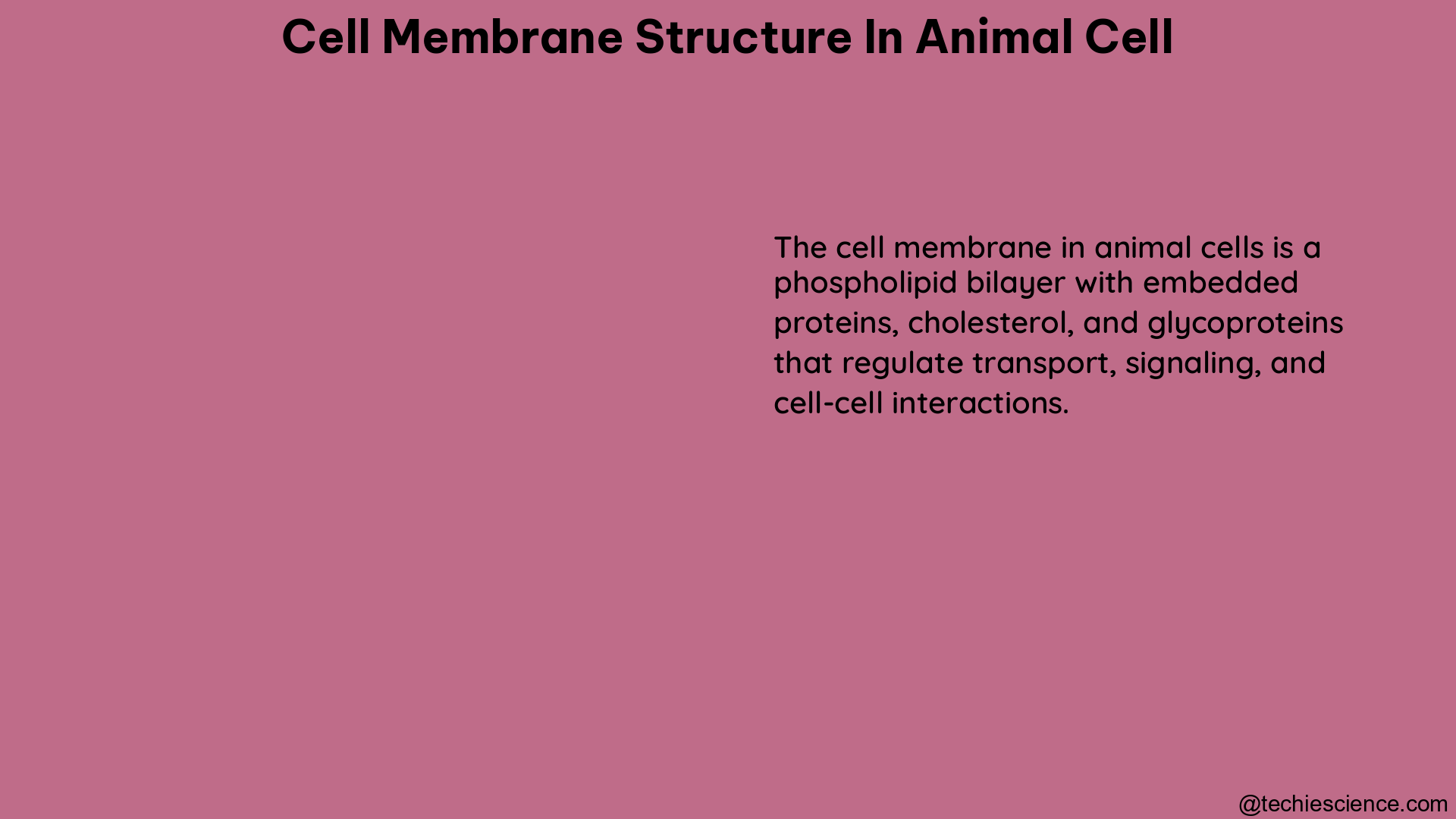The cell membrane, also known as the plasma membrane, is a crucial component of animal cells, serving as a selective barrier that regulates the movement of substances in and out of the cell. This fluid mosaic structure is composed of a phospholipid bilayer, proteins, carbohydrates, and cholesterol, each playing a vital role in maintaining the cell’s integrity and function.
The Phospholipid Bilayer: The Foundation of the Cell Membrane
The primary structural component of the cell membrane is the phospholipid bilayer, which consists of two layers of phospholipid molecules. These phospholipids are amphipathic, meaning they have both a hydrophilic (water-loving) head and a hydrophobic (water-fearing) tail. The hydrophilic heads face outward, interacting with the aqueous environment, while the hydrophobic tails are oriented inward, forming a barrier that prevents water-soluble substances from passing through.
The phospholipid bilayer is not a static structure; it is a dynamic and fluid mosaic, with the phospholipid molecules constantly moving and rearranging within the membrane. This fluidity is essential for the proper functioning of the cell membrane, as it allows for the movement and positioning of embedded proteins and other components.
| Phospholipid Composition | Percentage |
|---|---|
| Phosphatidylcholine (PC) | 40-50% |
| Phosphatidylethanolamine (PE) | 20-50% |
| Phosphatidylserine (PS) | 5-10% |
| Phosphatidylinositol (PI) | 5-10% |
| Sphingomyelin (SM) | 5-20% |
The specific composition of the phospholipid bilayer can vary among different cell types and even within different regions of the same cell membrane, contributing to its functional diversity.
Membrane Proteins: The Gatekeepers and Signaling Hubs

Embedded within the phospholipid bilayer are a variety of proteins, which play crucial roles in the cell membrane’s structure and function. These membrane proteins can be classified into several categories:
- Integral Proteins: These proteins are firmly embedded within the phospholipid bilayer, with portions extending on both the extracellular and intracellular sides of the membrane. They serve as channels, pumps, and receptors, facilitating the movement of specific molecules and transmitting signals across the membrane.
-
Examples: Ion channels, aquaporins, and G-protein-coupled receptors (GPCRs)
-
Peripheral Proteins: These proteins are attached to the surface of the membrane, either on the extracellular or intracellular side. They often serve as enzymes, structural components, or signaling molecules.
-
Examples: Cytoskeletal proteins, cell adhesion molecules, and signaling proteins
-
Lipid-Anchored Proteins: These proteins are attached to the membrane through a lipid anchor, such as a glycosylphosphatidylinositol (GPI) anchor, which is embedded in the outer leaflet of the phospholipid bilayer.
- Examples: GPI-anchored proteins involved in cell-cell recognition and signal transduction
The diversity and distribution of membrane proteins within the cell membrane are crucial for its functionality, allowing for the selective transport of molecules, signal transduction, and cell-cell communication.
Carbohydrates: The Cell’s Identification Tags
Attached to the extracellular surface of the cell membrane are carbohydrate molecules, known as glycans. These carbohydrates are covalently linked to either lipids (glycolipids) or proteins (glycoproteins), forming a glycocalyx layer that surrounds the cell.
The glycocalyx serves several important functions:
- Cell Identification: The unique carbohydrate patterns on the cell surface act as identification tags, allowing other cells to recognize and interact with the specific cell type.
- Cell-Cell Adhesion: The glycocalyx facilitates cell-cell adhesion, enabling the formation of tissues and organs.
- Receptor Binding: The carbohydrates on the cell surface can serve as binding sites for various molecules, such as hormones, growth factors, and pathogens.
The composition and distribution of the glycocalyx can vary significantly among different cell types, contributing to the diversity of cellular functions and interactions.
Cholesterol: The Regulator of Membrane Fluidity
Cholesterol is an essential component of the cell membrane, playing a crucial role in maintaining its fluidity and permeability. Cholesterol molecules are embedded within the phospholipid bilayer, interacting with the hydrophobic tails of the phospholipids.
At lower temperatures, the presence of cholesterol helps to maintain the fluidity of the membrane by preventing the phospholipids from packing too tightly together. This fluidity is essential for the proper functioning of membrane-bound proteins and the overall integrity of the cell.
Conversely, at higher temperatures, cholesterol helps to stabilize the membrane by reducing the fluidity and preventing the phospholipid bilayer from becoming too fluid and permeable.
The optimal cholesterol content in the cell membrane varies among different cell types and can be influenced by factors such as age, diet, and disease states.
Temperature and the Cell Membrane Structure
The structure and function of the cell membrane are highly sensitive to changes in temperature. Here’s how temperature affects the cell membrane:
-
Below 0°C (32°F): At temperatures below freezing, the cell membrane becomes very rigid and less permeable. The loss of kinetic energy in the phospholipids causes them to pack more tightly together, reducing the fluidity of the membrane. This can lead to the denaturation of membrane proteins and the formation of ice crystals during thawing, which can damage the cell.
-
0°C to 45°C (32°F to 113°F): Within this temperature range, the cell membrane is in a fluid, semi-permeable state. As the temperature increases, the kinetic energy of the phospholipids also increases, leading to greater membrane fluidity and permeability. This allows for the proper functioning of membrane-bound proteins and the selective transport of molecules across the membrane.
-
Above 45°C (113°F): At temperatures above 45°C, the phospholipid bilayer begins to break down, causing the membrane to become freely permeable. This can lead to the uncontrolled movement of molecules in and out of the cell, potentially causing the cell to burst due to water expansion from the heat.
The ability of the cell membrane to maintain its structure and function within a specific temperature range is crucial for the survival and proper functioning of animal cells.
Experimental Techniques for Studying Cell Membrane Structure
Researchers have developed various experimental techniques to quantify and analyze the structure and properties of the cell membrane in animal cells. Some of these techniques include:
-
Permeability Coefficient: The permeability of a given molecule across the cell membrane can be measured by its permeability coefficient, typically expressed in units of cm/s. This provides a quantitative measure of the membrane’s selective barrier function.
-
Fluorescence Recovery After Photobleaching (FRAP): This technique uses fluorescent labeling of membrane components, such as lipids or proteins, and then measures the rate of fluorescence recovery after a specific area of the membrane has been photobleached. This provides insights into the mobility and diffusion of membrane components, reflecting the fluidity of the membrane.
-
Single-Particle Tracking (SPT): SPT involves tracking the movement of individual fluorescently-labeled membrane components, such as proteins or lipids, to determine their diffusion coefficients and trajectories. This technique can reveal the heterogeneity and dynamics of the cell membrane.
-
Patch-Clamp Electrophysiology: This electrophysiological technique is used to measure the activity of ion channels and the membrane potential of cells. By applying a small glass pipette to the cell membrane, researchers can study the gating and conductance properties of specific ion channels, providing insights into the membrane’s electrical properties.
-
Atomic Force Microscopy (AFM): AFM is a high-resolution imaging technique that can be used to visualize the topography and nanoscale features of the cell membrane, including the distribution and organization of membrane proteins and lipids.
These experimental methods, combined with advanced imaging and analytical techniques, have significantly contributed to our understanding of the complex structure and dynamics of the cell membrane in animal cells.
Conclusion
The cell membrane in animal cells is a highly intricate and dynamic structure, composed of a phospholipid bilayer, proteins, carbohydrates, and cholesterol. This fluid mosaic model plays a crucial role in maintaining the cell’s integrity, regulating the movement of substances, and facilitating communication and interactions with the external environment.
Through the use of various experimental techniques, researchers have been able to quantify and analyze the structure and properties of the cell membrane, providing valuable insights into its function and the factors that influence its behavior. Understanding the cell membrane’s structure and its response to environmental changes, such as temperature, is essential for advancing our knowledge of cellular biology and developing targeted therapeutic interventions.
References
- Alberts, B., Johnson, A., Lewis, J., Raff, M., Roberts, K., & Walter, P. (2002). Molecular Biology of the Cell (4th ed.). Garland Science.
- Lodish, H., Berk, A., Zipursky, S. L., Matsudaira, P., Baltimore, D., & Darnell, J. (2000). Molecular Cell Biology (4th ed.). W. H. Freeman.
- Gennis, R. B. (1989). Biomembranes: Molecular Structure and Function. Springer.
- Edidin, M. (2003). The state of lipid rafts: from model membranes to cells. Annual Review of Biophysics and Biomolecular Structure, 32, 257-283.
- Sezgin, E., Levental, I., Mayor, S., & Eggeling, C. (2017). The mystery of membrane organization: composition, regulation, and roles of lipid rafts. Nature Reviews Molecular Cell Biology, 18(6), 361-374.

Hi, I am Saif Ali. I obtained my Master’s degree in Microbiology and have one year of research experience in water microbiology from National Institute of Hydrology, Roorkee. Antibiotic resistant microorganisms and soil bacteria, particularly PGPR, are my areas of interest and expertise. Currently, I’m focused on developing antibiotic alternatives. I’m always trying to discover new things from my surroundings. My goal is to provide readers with easy-to-understand microbiology articles.
If you have a bug, treat it with caution and avoid using antibiotics to combat SUPERBUGS.
Let’s connect via LinkedIn: